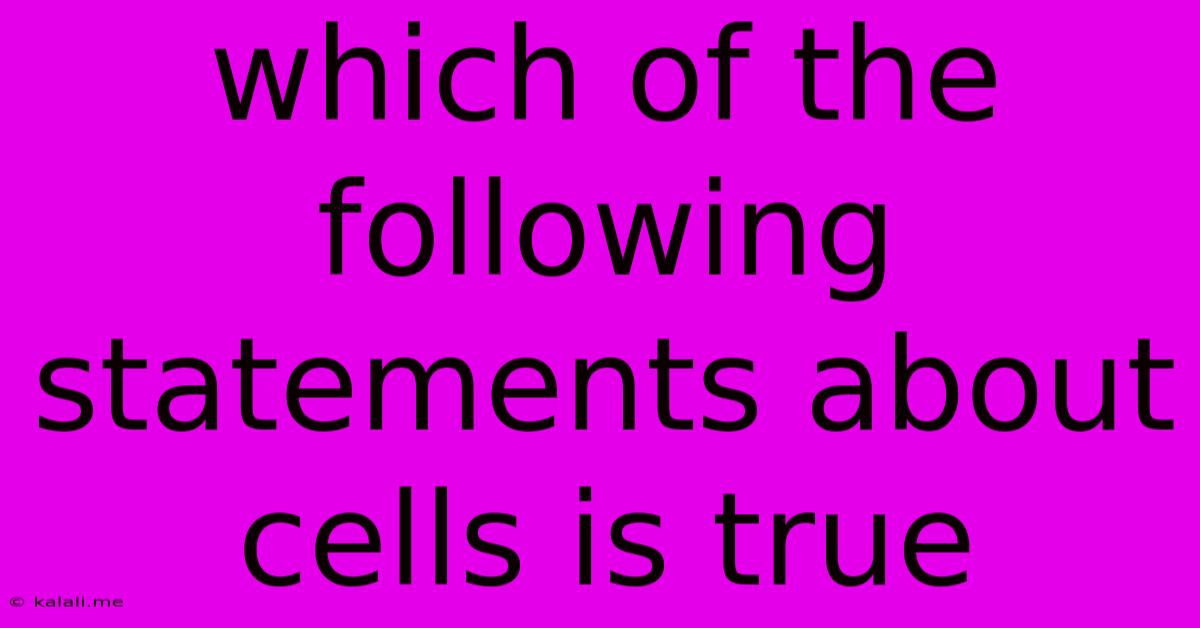Which Of The Following Statements About Cells Is True
Kalali
Jun 13, 2025 · 3 min read

Table of Contents
Which of the Following Statements About Cells is True? A Deep Dive into Cellular Biology
This article explores the fundamental characteristics of cells, addressing common misconceptions and clarifying key concepts. We'll delve into the intricacies of cell structure and function, ultimately answering the question: which statement about cells is true? Understanding cell biology is crucial, whether you're a student of biology, a curious individual, or simply interested in the building blocks of life.
The meta description below provides a brief overview and includes relevant keywords: This article clarifies common misconceptions about cells, examining key characteristics like structure, function, and differences between prokaryotic and eukaryotic cells. Learn which statement about cells is actually true and expand your understanding of cell biology.
Many statements about cells are made, some accurate and others inaccurate. To determine the truth, we must explore the core principles of cell biology. Let's consider some common assertions:
Common Statements About Cells (and their accuracy)
Here are some frequently encountered statements about cells, analyzed for accuracy:
-
Statement 1: All cells contain a nucleus. FALSE. While many cells do possess a nucleus (eukaryotic cells), prokaryotic cells, like bacteria and archaea, lack a membrane-bound nucleus. Their genetic material resides in a region called the nucleoid.
-
Statement 2: Cells are the basic units of life. TRUE. This is a cornerstone of cell theory. All living organisms are composed of one or more cells, and these cells are the fundamental units of structure and function in living things. Cells carry out all essential life processes, including metabolism, growth, and reproduction.
-
Statement 3: Plant cells and animal cells are identical. FALSE. While both are eukaryotic cells sharing some common features (e.g., membrane-bound organelles), they differ significantly. Plant cells have cell walls, chloroplasts (for photosynthesis), and large central vacuoles, which are absent in animal cells. These structural differences reflect their distinct physiological roles.
-
Statement 4: All cells are microscopic. FALSE. While many cells are microscopic and require magnification to be seen, some cells, such as certain types of algae and some nerve cells (neurons) can be quite large and visible to the naked eye.
-
Statement 5: Cells can only reproduce asexually. FALSE. While asexual reproduction (e.g., binary fission in bacteria) is prevalent, many cells reproduce sexually through meiosis and fertilization. Sexual reproduction generates genetic diversity within populations, enhancing adaptation and evolution.
Understanding Eukaryotic vs. Prokaryotic Cells: A Key Distinction
The difference between eukaryotic and prokaryotic cells is critical in understanding cellular diversity. Eukaryotic cells, found in animals, plants, fungi, and protists, are characterized by their complex organization, including a membrane-bound nucleus, numerous organelles (specialized structures), and a cytoskeleton. Prokaryotic cells, on the other hand, are simpler, lacking a nucleus and other membrane-bound organelles.
Conclusion: The Truth About Cells
Based on our analysis, the statement that accurately reflects the nature of cells is: Cells are the basic units of life. This fundamental principle underpins our understanding of biology and serves as a foundational concept in various scientific fields. The other statements highlight the diversity and complexity within the cellular world, emphasizing the importance of nuanced understanding of cell structure and function. This article has hopefully illuminated the essential characteristics of cells, clarifying common misconceptions and providing a deeper appreciation for these fundamental units of life.
Latest Posts
Latest Posts
-
Unit Of Overall Heat Transfer Coefficient
Jun 14, 2025
-
How To Write A Letter Requesting A Promotion
Jun 14, 2025
-
Colorado School Of Mines Acceptance Rate Out Of State
Jun 14, 2025
-
Which Of The Following Is Part Of The Hydrosphere
Jun 14, 2025
-
The Internal Resistance Of An Ideal Voltage Source Is
Jun 14, 2025
Related Post
Thank you for visiting our website which covers about Which Of The Following Statements About Cells Is True . We hope the information provided has been useful to you. Feel free to contact us if you have any questions or need further assistance. See you next time and don't miss to bookmark.